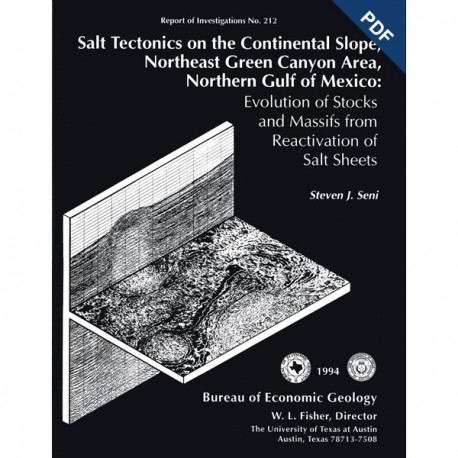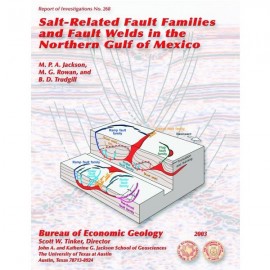Reports of Investigations
-
Books & Reports
- Reports of Investigations
- Guidebooks
- Udden Series
- Geological Circulars
- Down To Earth
- Atlases of Major Oil and Gas Reservoirs
- Texas Memorial Museum Publications
- Environmental Geologic Atlas of the Texas Coastal Zone
- Mineral Resource Circulars
- Other Reports
- Seminars and Workshops
- Handbooks
- Submerged Lands of Texas
- Symposia
- Annual Reports
- Open File Reports
-
Maps & Cross Sections
- Thematic Maps
- Miscellaneous Maps, Charts & Sections
- Geologic Atlas of Texas
- STATEMAP Project Maps
- Geologic Quadrangle Maps
- Cross Sections
- Highway Geology Map
- Energy and Mineral Resource Maps
- Shoreline Change and Other Posters
- Wilcox Group, East Texas, Geological / Hydrological Folios
- Bouguer Gravity Atlas of Texas
- River Basin Regional Studies
- Featured Maps
- Posters
- Teachers & the Public
-
Geological Society Publications
- Gulf Coast Association of Geological Societies
- Alabama Geological Society
- Austin Geological Society
- Corpus Christi Geological Society
- Houston Geological Society
- Lafayette Geological Society
- Mississippi Geological Society
- New Orleans Geological Society
- South Texas Geological Society
- GCS SEPM Publications
- Historic BEG & UT Series
Salt Tectonics on the Continental Slope, NE Green Canyon Area, Northern Gulf of Mexico...Digital Download
RI0212D
For a print version: RI0212.
RI0212D. Salt Tectonics on the Continental Slope, Northeast Green Canyon Area, Northern Gulf of Mexico: Evolution of Stocks and Massifs from Reactivation of Salt Sheets, by S. J. Seni. 102 p., 59 figs., 4 tables, 1994. doi.org/10.23867/RI0212D. Downloadable PDF
To purchase this publication in book format, please order RI0212.
ABSTRACT
Data from conventional two- and three-dimensional seismic surveys and wells were used to analyze the morphology of salt structures and to determine the history of salt emplacement in a 1,500-mi2 (3,885-km2) region of the continental slope, northeast Green Canyon Area. Salt structures within the region include stocks, massifs, an allochthonous sheet, and remnant-salt structures. Also within this region is a largely salt free area (at least to a depth of 20,000 to 25,000 ft (6,100 to 7,600 m) that coincides with a U-shaped submarine trough. A large graben between an east-northeast-trending zone of growth faults near the shelf margin and a parallel trend of counterregional growth faults located 30 to 40 mi (48 to 64 km) basinward contains the submarine trough, stocks, and massifs. This graben is inferred to have formed from extension and subsidence as burial of the landward portion of a thick salt sheet produced massifs and stocks by downbuilding. Large-displacement counterregional growth faults form the northern, landward margin of a large salt sheet that extends to the Sigsbee Escarpment.
Differential loading separates salt stocks and massifs from the trailing margin of a salt sheet. During sheet burial, the landward margin of the sheet is segmented into discrete, irregular massifs separated by salt-withdrawal basins. These massifs are in turn segmented into stocks. The early stage of salt structural evolution of stocks and massifs is similar. The deeply buried margins of stocks, massifs, and remnant-salt structures are geometrically and structurally analogous to salt rollers, indicating a common pattern of structural evolution. This structural pattern includes initial growth under thin cover in an extensional regime. Strata thin over the crest and onlap the flanks of the structures. Thickness variations indicate syndepositional salt structural evolution under thin (<1,000 ft [<300 m]) cover.
The former presence of salt below the submarine trough is inferred on the basis of remnant-salt structures and a turtle-structure anticline lying on a discontinuity. Where salt is absent, this discontinuity is a salt weld representing suturing of sediments formerly separated by a salt sheet. Age of sediments below the weld indicates that sheet extrusion occurred in late Miocene to early Pliocene (4.6 to 5.3 m.y.a.). The age of sediments above the weld is late Pliocene (2.8 to 3.5 m.y.a.). In the submarine trough, sheet burial began in the late Pliocene and around the massifs burial continued from the early Pleistocene to the Holocene.
Keywords: differential loading, Gulf of Mexico slope, massifs, salt weld, sheet evolution, stocks, turtle structure
Citation
Seni, S. J., 1994, Salt Tectonics on the Continental Slope, Northeast Green Canyon Area, Northern Gulf of Mexico: Evolution of Stocks and Massifs from Reactivation of Salt Sheets: The University of Texas at Austin, Bureau of Economic Geology, Report of Investigations No. 212, 102 p. doi.org/10.23867/RI0212D.



